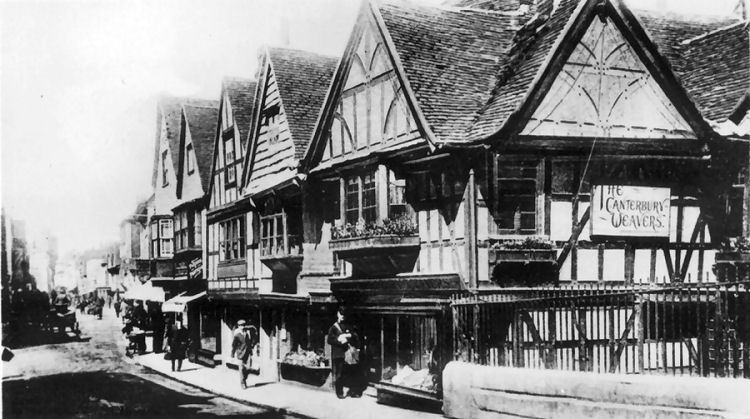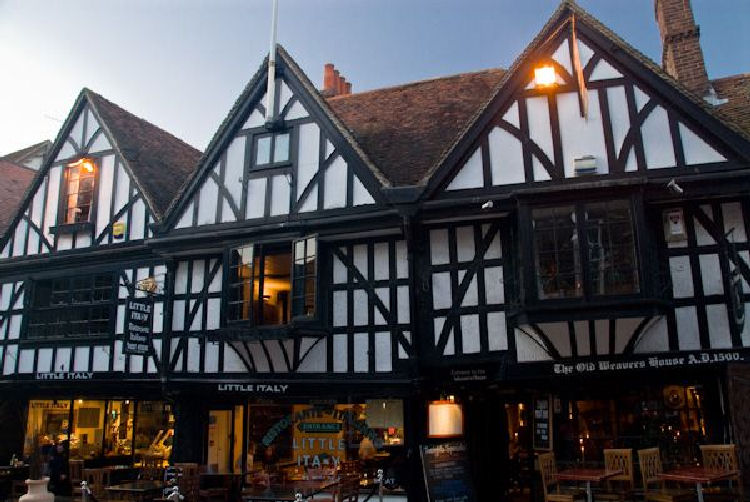Sort file:- Canterbury, March, 2021. |
|||||||
Page Updated:- Wednesday, 31 March, 2021. |
|||||||
| PUB LIST | PUBLIC HOUSES | Paul Skelton | |||||
|
Earliest 2011- |
Old Weavers House |
Open 2014+ |
|||||
|
3 St. Peter's Street Canterbury
In 1889 the premises was home to H Z Davey of the Whitehall Dairy. Other mentions include the following:- 1903 J. Everard Butcher and Milk Contractor. The address being 3 King's Bridge.
HISTORY The old weavers house & the Canterbury weavers. ''The old Weavers' House'' was the name accorded to No's 1, 2 & 3, originally one Building, No 1 being riverside, at the King's bridge and indicates a significant historical Period which began in the 16th century when weaving was undertaken here. ''the Canterbury weavers'' was the name applies to No's 1 & 2 when a revival of the Craft took place at the end of the 19th century. Although dated on its sign as 1500, much of the structure of the building is earlier with the foundation having been laid in the 12th century. The fabric of the street frontage is 15th century with 16th to 20th century alterations and additions. The external river frontage which has been much altered and extended from three to five gables, disguises the original 15th century fabric. In the interior of the building much of the original Tudor structure has survived with Jacobean, Georgian and later additions. Weaving centres were established in Canterbury in the 16th century when Walloon and Huguenot refugees settled here, as elsewhere. Known as ''the strangers'' these newcomers established their work places, especially by the river Stour, and soon had their looms at work weaving ''Bayes and says, Grograines'' and many other fabrics. The prosperity which their industry brought to the city was acknowledged in 1574 by the magistrates of Canterbury; and it is suggested that it was around this time when ''the quaint old gabled house at King's Bridge'' became one of their places of work, With later-found evidence confirming it had been used as such. Prosperity peaked in the 1690s, but decline followed largely due to foreign imports. Then a fresh impetus was given to the trade in 1787 when John Callaway, master of the city silk weavers introduced his "Canterbury Muslins" soon of acclaimed renown. However due to changes in fashion and demand the industry was all but over at the start of the 19th Century; and by this time an inn, the "Golden Lion," was in the third part of the building. A period followed in which Nos 1, 2 & 3 were used as separate trading or retail units during which No 1 was mainly a laundry. No 2 fruiterer's, and No 3 dairy outlet. Then weaving returned to the premises after Miss Edith Holmes and Miss Constance Philpot's established a weaving school, a revival of the craft, for women and girls in need of work. Initially in other premises they moved in 1899 to No's 1 & 2 of the old building by King's Bridge, thereby named the Canterbury Weavers, and linked to the past by the items found during restoration work: fragment of loom, bobbins, fabrics, Old English tokens and Dutch tiles, and traces of hoists to link with river-transport. The School closed in 1914, but the premises long continued as outlets for the woven goods, before becoming other retail units. Today no 1, and No's 2/3 are restaurants, With No 3, "the Weavers' Restaurant" retaining in its name much of Canterbury's history.
"Old Weavers House" is a half-timbered building on the River Stour. The river quite literally laps at the side of the building, which currently houses the restaurant. Originally the "Old Weavers House" was named by Flemish and Hugenot weavers who settled in the area after fleeing from religious persecution during the 16th and 17th centuries. Elizabeth I granted the Flemish weavers the right to establish their businesses in Canterbury, and they are known to have used this and other similar buildings nearby. The date 1500 seen displayed above the door is misleading as the house dates back to at least the 14th century. The current building being a reconstruction about 1550. At the rear of the Old Weavers House is a medieval ducking stool, jutting out over the river. This ducking stool was historically used as a method of punishing 'scolds' - women accused by their husbands of talking back too much! The stool may also have been used as a more severe punishment for suspected witches. The suspected witch was dunked under the water and held there for several minutes. If she (it was usually a female) did not drown, she was proved a witch. If she drowned, at least her name was cleared! Although the house goes back to the 14th century, the restaurant and public bars, I do not know how long they have been operating for. Local knowledge needed here.
LICENSEE LIST BIGG Edward date unknown (Publican and Lodging House)
https://pubwiki.co.uk/OldWeaversHouse.shtml http://www.closedpubs.co.uk/oldweavers.html
|
|||||||
|
If anyone should have any further information, or indeed any pictures or photographs of the above licensed premises, please email:-
|
|||||||
| TOP |
|
|
|||||

